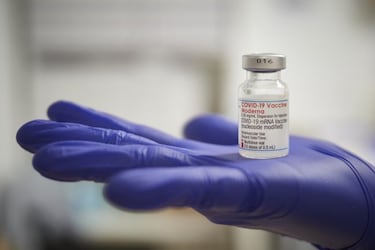New side effects added to Janssen, Moderna vaccine product info
In its latest safety report, the European Medicines Agency has updated its list of recognised side effects of vaccines against covid-19.


The European Medicines Agency (EMA) has updated its list of side effects associated with covid-19 vaccines, recommending amendments to the product information for the Janssen and Moderna shots.
The Janssen and Moderna jabs are two of five vaccines approved for use in the European Union and European Economic Area (EU/EEA), alongside the Pfizer, AstraZeneca and Novavax vaccines. In the United States, the Federal Drug Administration (FDA) has issued emergency or full approval to Janssen, Moderna and Pfizer.
While Janssen uses a modified version of another virus to combat the coronavirus that leads to covid-19, the Moderna vaccine harnesses mRNA technology. Essentially, mRNA is a messenger that teaches the cells in our body how to create the proteins that spark an immune response to the virus.
The Janssen vaccine is initially administered as a single injection. As of 28 February, 19.2m doses of the drug had been given to people in the EU/EEA, the EMA says. In the US, 18.5 million doses had been administered as of 10 March, per the Centers for Disease Control and Prevention (CDC).
Meanwhile, the Moderna shot comprises two initial injections. 152m doses of the vaccine had been given in the EU/EEA as of 28 February, and just under 210m had been injected in the US as of 10 March.
EMA's vaccine side effects update: Janssen
In its latest monthly safety report, released on 17 March, the EMA’s Pharmacovigilance Risk Assessment Committee (PRAC) said it had recommended that cutaneous small vessel vasculitis be added to the Janssen vaccine’s product information as a potential side effect “of unknown frequency”.
The EMA describes cutaneous small vessel vasculitis as “inflammation of blood vessels in the skin which may result in a rash, pointed or flat, red spots under the skin’s surface and bruising”.
The body had previously recommended the inclusion of cutaneous small vessel vasculitis on Janssen’s product information in its September safety update, before suspending this conclusion after the pharmaceutical company asked for a re-assessment.
While the EMA does not provide an estimation of the incidence rate of cutaneous small vessel vasculitis as a side effect of the Janssen vaccine, the agency categorises it as a “very rare” event.
See also:
EMA's vaccine side effects update: Moderna
Meanwhile, the EMA said it has recommended that the Moderna vaccine - also known as Spikevax - include a warning that the shot can lead to a reoccurrence of capillary leak syndrome (CLS) in patients with a history of suffering from the condition.
According to the US’ Department of Health and Human Services, capillary leak syndrome causes fluid to leak from capillaries (small blood vessels). Symptoms can include low blood pressure; loss of albumin from the blood; thickened blood; general swelling; fluid in the lungs and around the heart; kidney failure; stroke; and heart failure.
The EMA notes that its assessment of the “extremely rare” condition included incidences where flare-ups occurred after the Janssen vaccine was administered, but not necessarily because of the jab.

What other side effects do Janssen and Moderna vaccines have?
In both the Janssen and Moderna vaccines, the most frequent side effects include pain at the injection site, tiredness, muscle pain and nausea. The Moderna shot can also lead to swelling and/or pain in the lymph nodes under the arm - a common side affect among mRNA vaccines.
Among the rarer, more serious side effects, thrombosis with thrombocytopenia syndrome (TTS) “may affect up to 1 in 10,000 people” given the Janssen vaccine, the EMA says. TTS is a combination of the formation of blood clots in the blood vessels and low levels of blood platelets. In the US, there have been 59 confirmed reports of TTS among the 18.5m Janssen doses issued, according to the CDC.
In “up to 1 in 10,000 people”, says the EMA, the Moderna vaccine can cause myocarditis - inflammation of the heart muscle - and pericarditis - the inflammation of the tissue surrounding the heart muscle.
Related stories
Anaphylaxis, an extreme allergic reaction, has also been known to occur after vaccination against covid-19, but is very rare. It has affected around five people per one million in the US, the CDC says.
“The benefits of all currently authorised COVID-19 vaccines continue to outweigh their side effects, given the risk of COVID-19 illness and related complications, including hospitalisation and death,” the EMA concludes in its safety update.

